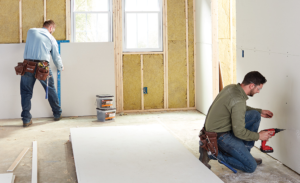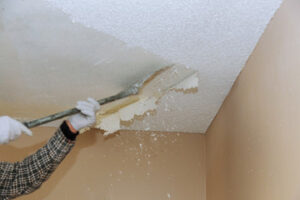Drywall Installation Naperville can give a room a finished look. However, doing it properly requires expert skills and the right tools.
For instance, driving drywall screws correctly is a skill that takes practice to master. Similarly, applying joint compound smoothly requires an eye for detail. This is why hiring a professional is often the best option.

Drywall installation is an important part of any remodeling or construction project, laying the foundation for your new wall’s appearance and structural integrity. However, the process can be difficult to navigate without the right knowledge and guidance. Whether you are a DIY homeowner or working with professional contractors, understanding the key steps to the process and common challenges can help you successfully complete your project.
Begin by clearing the area where the drywall will be installed. Remove furniture, fixtures, and electrical covers to create a safe and unobstructed workspace. It is also a good idea to sweep the floor to remove any debris that might be in the way of your work. If there are items that cannot be moved, cover them securely with plastic sheets or tarps to protect them from dust and debris.
Before beginning drywall installation, inspect the walls and ceilings for any existing damage. It is important to repair any cracks or holes before beginning because these problems may affect the finished product. Using high-quality patching compound, fill any cracks or holes. It is also a good idea to use fiberglass tape over these areas, which adds strength and reduces future cracking.
During the preparation stage, it is also essential to ensure that the framing is flat. This can be achieved by sanding the edges of the wall or demanding that others do so before starting drywall installation.
Next, mark the location of all studs with a stud finder. It is a good idea to stagger the studs on 16” or 24” centers, which will add to the strength of the wall and prevent cracking. It is also a good idea to check that the studs are on true center, as sometimes they can be off due to sloppy carpentry.
Finally, apply a thin layer of joint compound to the seams between drywall sheets. Use a drywall taping knife to spread the compound and to ensure there are no gaps or loose spots. After the first coat dries, apply additional layers as needed. Be sure to sand between each application of compound for a smooth surface.
Cutting
Drywall installation is a complex project that requires attention to detail. Many people choose to work with a contractor, particularly if they’re unfamiliar with the process and want to ensure that the job is done correctly. Nevertheless, homeowners can reduce costs by familiarizing themselves with the process and learning best practices. For example, when cutting drywall, it’s important to be precise in order to achieve a clean and seamless finish.
Before you start cutting, make sure that the workspace is free of debris and that there’s enough light to see your work clearly. If possible, lay the drywall sheet flat on a work surface, such as a pair of sawhorses or a table. Using a sharp utility knife, score the panel along the mark that you made earlier. Make sure to press firmly but not cut all the way through the paper on the back of the panel. Once the sheet has been scored, it can be snapped using a drywall saw or rotary tool.
If you need to cut a hole for a window, door or electrical outlet or fixture, measure the size of the opening and mark the outline on the drywall. This will give you an accurate line to follow when cutting the hole. It’s usually easier to use a drywall saw for these types of cuts, but if you don’t have one available, a utility knife will work just fine.
After the drywall sheets have been cut and secured to the wall or ceiling, seams and joints are concealed with joint tape and joint compound, also known as mud. The first strip of tape is applied to the edge of each seam, and then additional layers are applied, feathering out each application so that it blends into the adjacent drywall. The mud is then sanded down, and any screw holes are filled in for a smooth finish.
Bulges and bumps in drywall can be caused by improper installation or an underlying issue with the framing. In addition to ensuring that each panel is properly fastened, run your taping knife gently over the edges of each sheet to determine whether any areas are loose or uneven.
Hanging
The process of hanging, taping and finishing drywall is an integral part of creating finished walls and ceilings. It is important to have a professional who understands how to properly install drywall in order to achieve an aesthetic and quality result. A well-done framing job is essential, as is a precise installation of the drywall sheets. After the drywall is hung, it must be taped and finished with joint compound (sometimes called mud) to provide a smooth surface that is ready for painting or other finishes. The hanging, taping and finishing process is a complex and time-consuming procedure that requires knowledge of proper techniques and tools.
The first step in the drywall hanging process is to secure the sheet of gypsum board to the studs or ceiling joists with drywall screws. When doing this, it is important to use a screw gun that allows you to regulate the depth of the screw. This will help prevent damage to wires that can occur when a screw is driven too far into the drywall.
Next, the installer must cut around windows, doors and electrical boxes. It is helpful to mark the drywall panel prior to cutting, if possible. Using a dry-erase marker, a line can be marked on the face of the drywall. This will allow the installer to see where the drywall should be cut in order to create a hole that is large enough for the window, door or electrical outlet. If this is not possible, a spiral saw can be used to cut the drywall around the fixture.
It is a good idea to work in rows, working from one side of the room to the other. This will ensure that all seams are evenly spaced and reduce the possibility of unsightly bumps or bulges in the drywall. It is also a good idea to leave a small gap between the bottom drywall and the floor, which will be covered by baseboard trim later.
It is important to sit the ends of the drywall panels on a stud, whenever possible. This will prevent a butted seam, which can be a source of weakness and cracking in the future. If you cannot avoid a butted seam, you can try to minimize it by utilizing long panels and staggering the ends of the non-tapered edges of each panel.
Finishing
Drywall isn’t complete until the seams and edges are taped, sanded and finished. This step is labor-intensive and requires great attention to detail to make the walls smooth, visually free of imperfections and ready for paint, wallpaper or other coverings. It is important to use a drywall dust mask during this process and be sure the room is well-ventilated to minimize the risk of respiratory problems.
To prepare for sanding, first run your hand over the wall to feel for any bumps or ridges. You can also use a drywall square to check for levelness. If any studs are off-center, use a drywall stud finder to locate the center of the stud and mark it with a piece of masking tape. This will help you get the mud in the right spot and avoid having to cut any end pieces to fit on the correct stud.
You should have the following materials for this stage of drywall installation:
A 6-inch joint knife-you’ll use this to apply your first coat of mud, called the tape coat. Next, place drywall tape along each seam and spread additional mud over the tape to firmly adhere it. This second coat of mud is called the block coat. It is critical to use a firm, even coating over the entire area, especially around electrical boxes and switch plates.
When the third and final coat of mud, or skim coat, is applied, it will cover up any remaining uneven areas of the wall. It’s best to apply this coat when the surface is completely dry, ideally after 12 hours. Once the skim coat is on, it’s critical to smooth it down using a hand sander and a piece of 120-grit sandpaper. You can also use a sanding sponge for tight spaces and corner joints. During this stage, you should also keep a piece of marking chalk handy to mark touch-up areas that need to be sanded.
It’s essential to follow the steps outlined above for proper drywall installation, particularly when dealing with large projects. If you are unsure about your abilities to handle a project like this, it’s always better to hire a contractor than to attempt it on your own and make costly mistakes that could result in expensive repair bills or even structural damage.

